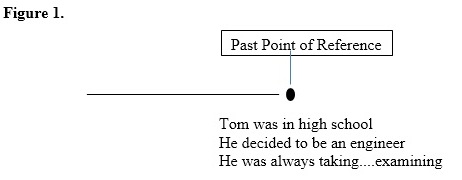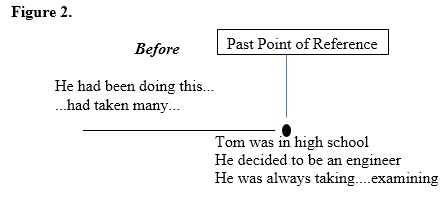









Douglas Adams

|









|
Editor: Douglas Adams |
|
|
|
Language is organized. This may seem like an obvious statement, but if it is in fact true, then why do we so often try to teach it as if it were a list of rules rather than an organized system with predictable patterns and forms that can be inferred by language learners. Of all the skills we try to teach our students, grammar is perhaps the one least often taught as an organized structure, yet grammar is most easy to understand and to teach when we look at it as a complete system rather than a list of rules, and the verb tense/aspect system is no exception.
where "be" means some form of the verb be, and "have" means some form of the verb have. Note: I prefer to use the term continuous rather than progressive since it better describes the implied continuing nature of a verb in this tense. The only exceptions to these forms are with the simple tenses (which are, in fact, not all that simple for students after all). Let's examine the tense system in more detail, and begin with the past tenses. The Past Tenses [Table Format]
Learning the formulas for the past tense verbs is only part of the story, and not the hardest part. The part that troubles students the most is when it comes to knowing how to use these tenses. Grammar doesn't happen in isolation, so let's look at an example in context. When Tom was in high school, he decided to be an engineer, and he was always taking apart small machines and examining them. He had been doing this since he was a small child, and had taken many math and science courses since he started school.
In this short example, we can see each of the four past tenses in context, and can ask students to identify them. At this point it becomes possible to ask students when each of these actions happened and place them on a time line to better visualize their relationship to one another.
We can use the simple past and past continuous tenses to talk about some actions that happened or were happening at some point in the past. In other words, these tenses place us at some particular point of reference in the past, and show us what things happened or were happening at that point in time...
 It's worth noting that at this point students often ask about the difference between using the simple past and the past continuous. We can address this question through a combination of two things:
Returning to our sample paragraph, we can also notice that the past perfect and past perfect continuous tenses are used to talk about things that happened or were happening before the simple past and past continuous actions. In fact, we can think of the perfect tenses as the before tenses since they are always used for actions that happen before some past point of reference even if that point is merely implied and not directly stated.
 ** the continuous form of the verb implies that Tom continued to do this even up to the point he decided to become an engineer. This is a common use of the past perfect continuous, but it doesn't have to carry this meaning. He could have been taking these classes for a while, and then stopped taking them at sometime before he later decided to become an engineer. Essentially this pattern of the simple and continuous tenses establishing a point of reference in time and the perfect and perfect continuous tenses describing actions happening before that point is repeated for all the tenses (past, present, and future). Let's see how this plays out for the present tenses and examine how the past and present tenses relate to one another. *Grammarians would have us distinguish between tense and aspect, but for the purposes of language instruction, it's unnecessary. |
|||||||||||||||||||||||||||||||||||||||||||||||||||||||||||||||||||||||||||||||||||||||||||||||||||||||||||||||||||||||||
|
|
|||||||||||||||||||||||||||||||||||||||||||||||||||||||||||||||||||||||||||||||||||||||||||||||||||||||||||||||||||||||||||
|
|
http://www.tesltimes.org |